Tech Presidents

Charles O. Thompson was selected as the first president of the Worcester County Free Institute of Industrial Science. Upon his shoulders fell the responsibility for carrying out the new plan, organizing the courses, and selecting the original staff of professors and instructors. What WPI has since become is due in no small measure to the impetus given by him at the beginning. Thompson served from the opening of the Institute, in 1868, until 1882. During his presidency, the only buildings on campus were Boynton Hall and the Washburn Shops.
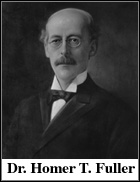
Succeeding Thompson, Homer T. Fuller served as the second president, from 1883 to 1894. The Institute underwent much growth and change during Fuller’s tenure. The Salisbury Laboratories were completed and the Pi Iota chapter of Phi Gamma Delta appeared on campus, becoming the first recognized fraternity. A state grant made possible the construction of the president’s house, the Power Laboratory, and the new mechanical engineering building, which is now Stratton Hall. A large addition was made to the Washburn Shops, and the first course in electrical engineering was introduced during Fuller’s presidency. In July of 1887, the name of the school was changed from Worcester County Free Institute of Industrial Science to Worcester Polytechnic Institute.
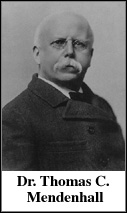
Thomas C. Mendenhall assumed the third presidency, from 1894 to 1901. His period of service saw the reorganization of the mechanical engineering course and the appointment of the first professor of electrical engineering. It was also during his presidency that the long-standing philosophical dilemma over the proper role of the Washburn Shops was settled. Mendenhall had the difficult task of modifying that role from one of commercial enterprise to one of a teaching and research facility.
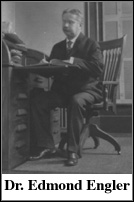
Edmond A. Engler, the fourth president, served from 1901 to 1911. It was under his presidency that the foundry and the electrical engineering building (now known as Atwater Kent Laboratories) were erected. Also during this time enrollment doubled, the departments were reorganized, postgraduate courses were incorporated into the curriculum, and scientific and engineering societies were established on campus along with a senior honor society.
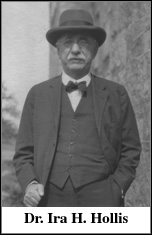
Ira N. Hollis assumed office in 1913 and served as fifth president until he retired in 192/5. Under his guidance, the Institute passed through the dark period of World War I, which took a worthy part of its teachers and students in the great struggle. Hollis created the Alumni Fund and the $2 million General Endowment Fund. During his tenure, Alumni Gymnasium was built and the Physical Education Department was organized. Also during Hollis’ term, on November 14, 1914, Alumni Field saw its first action, with a football game against RPI in which WPI (also commonly referred to as "Tech") scored a 14-0 shutout.
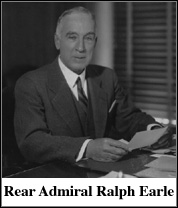
Rear Admiral Ralph Earle (son of Stephen C. Earle, architect of Boynton Hall) came to the Institute in 1925 as its sixth president and continued down the same path as the men of conspicuous ability who filled the office before him. Under Earle’s leadership, the Institute entered a new era of progress, marked by the completion of the Fuller Swimming Pool and Sanford Riley Hall.
Shortly before his death on February 13, 1939, Earle completed plans and secured funds for the greatest expansion of the campus in the school’s history. In addition to campus improvements, Earle injected a spirit of goodwill and good sportsmanship into the life of the Institute. He was an ardent supporter of student activities and gave himself generously to the solution of student problems.
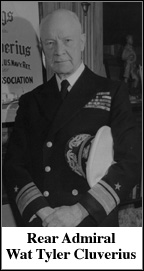
On June 15, 1939, the Board of Trustees named Rear Admiral Wat Tyler Cluverius seventh president, succeeding Earle. (Cluverius assumed the presidency in August, relieving Professor Francis W. Roys, who had served as acting president in the interim.) The Cluverius presidency, which lasted through 1952, saw many trials and triumphs. The advent of war in 1941 caused an immediate and drastic change in life at Tech. During the war years, many students left college to join the service. In 1942, at the request of the U.S. Navy, WPI taught naval students in the V-12 and V-5 programs. Sanford Riley Hall was used as officers’ quarters and barracks while Stratton Hall was used as quarters for the Navy seamen, who lived on campus from 1942 until the spring of 1946. Even after the departure of the V-12 students, WPI remained in an accelerated program until July 1947.
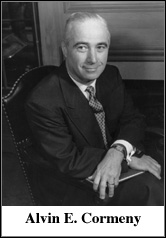
In 1953, Alvin E. Cormeny took over as eighth president and served a brief, yet important, term in office. It was Cormeny who first outlined what was soon to be known as the WPI Plan. In paragraph after paragraph of far-sighted perspective, he predicted what Tech might someday become—and since has become.
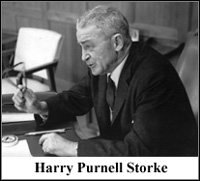
Arthur B. Bronwell was inaugurated as ninth president in 1955. Under his leadership, work began on the complete renovation of Boynton Hall and continued progress was made in the field of engineering education at WPI. In the spring of 1956, the modernization of the Institute’s oldest building was completed.

In October 1962, Harry Purnell Storke became the 10th president, and WPI began an era of growth and expansion the likes of which the college had never seen. As part of a 10-year development plan, several buildings were added to the campus: Daniels Hall, Goddard Hall, George C. Gordon Library, and Harrington Auditorium. A.J. Knight Field was dedicated during this time.
On May 18, 1967, the faculty of WPI voted to accept a report that called for programs leading to degrees in majors outside of science and engineering. The new programs were economics, business management, and humanities. A new way to battle the cost of tuition—the workstudy program—was initiated in the fall of 1967.

In 1968, Storke, recognizing the need to revamp the WPI curriculum, which had devolved into a traditional, rigid engineering program, appointed a faculty planning committee that would, over the next two years, develop the program now known as the WPI Plan.
The administration realized that something was also missing from the student life at WPI and decided to fill the gap with a student union. In the early months of 1967, renovation began on the sub-basement of Riley Hall. The original plan was to have a main lounge and two smaller ones, but these plans changed so much that by the end of the year, the student union had been transformed into a senior pub. Students were asked to suggest names for the new facility and "The Goat’s Head Pub" was selected since it recalled an old Tech tradition. The pub opened November 10, 1967. In 1991, the pub was completely renovated and, named Gompei’s Place, served as the campus deli and pizzeria.

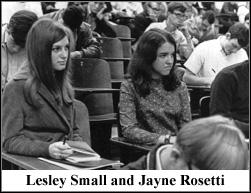
Women started to make their presence noticed on campus in the fall of 1967, when Barbara Murphy became the first woman faculty member. In 1968, the Board of Trustees voted to admit women undergraduates, breaking WPI’s century-old tradition of an all-male student body. The first women were admitted in the fall of 1968 as commuters, as there was no female housing at the time. Lesley Small and Jayne Rosetti, both mathematics majors, were the first to enroll. The following year 24 women were admitted. While five commuted, 19 women lived on the first floor of Sanford Riley Hall.
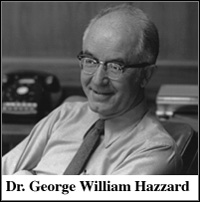
In June of 1968, amid this era of change, Storke announced his plan to retire at the close of the school year. WPI trustees chose George W. Hazzard as the Institute’s 11th president. During Hazzard’s presidency, Lesley Small became the first undergraduate woman to earn her degree from WPI. In another step toward the establishment of women as a presence on campus, Maryann Bagdis became WPI’s first female student body president in April 1970.
But bigger changes were yet to come. Soon Hazzard and the rest of the campus found themselves in the midst of implementing the WPI Plan, which went into effect in the fall of 1971. The Plan was the result of four major reports, nine subcommittees, two planning days, countless faculty meetings and questionnaires, and endless—often heated— discussions. It was formally approved by the faculty on May 29, 1970, after Storke had retired.
The Colleges of Worcester Consortium also was established in 1970. Within this program students in each of the nine area colleges could take courses, free of charge, at any school in the consortium, as well as attend any social event put on by these colleges.
In the fall of 1970, the Student Affairs Office conducted an experiment in which dormitory counselors were replaced with resident advisors. Needless to say, the experiment was a success and the new system was permanently implemented. In 1972, the WPI judicial system was established on campus, consisting of the Dormitory Hearing Board, the Campus Hearing Board, and the Presidential Board of Appeals. The boards were made up of both students and faculty members.
Beginning in the fall of 1975, WPI made it possible for students to receive graduate credit for certain courses they took as undergraduates. This new system decreased the workload for graduate students, allowing them to receive a master of science degree by remaining at WPI for only one extra year.
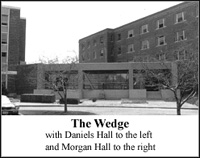
During the second half of the 1970s, the "Wedge" was added connecting Daniels Hall and Morgan Hall, and renovations to Salisbury Labs, Boynton Hall, Sanford Riley, Washburn Shops, and Daniels Hall were completed.
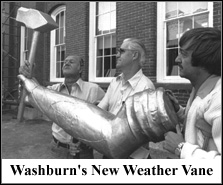
Late one night in October 1975, an individual climbed to the top of Washburn Tower and stole WPI’s beloved arm and hammer weathervane. The thief was never caught, and the weather vane was never recovered. A ransom note was received, but not until the ransom date had already passed. A year and a half later, through the generosity of a local guild worker, a new weathervane was produced and donated to the campus, restoring a vital piece of WPI history.

In late 1977, Hazzard announced his intention to retire, and soon after, the Board of Trustees chose Edmund T. Cranch to follow as the 12th president of WPI. He took office in 1978. During his presidency, WPI made capital improvements to the campus, including the renovation of Atwater Kent Laboratories, Kaven Hall, and Washburn Shops. In 1981, biotechnology was added as a new major and the first courses were taught during the 1982-83 school year.

In 1985, the Board announced the appointment of Jon Calvert Strauss as the 13th president, following Cranch’s resignation. In the fall of 1989, a steering committee was created to develop a Strategic Plan based upon earlier committee research. The faculty adopted this plan on March 22, 1990, which established goals and strategies for the Institute through the 1990s. The Strauss era saw an increased emphasis on research and scholarship, with many new labs and centers and a large growth in research funding. Fuller Laboratories was constructed and Alden Memorial renovated, the campus computer network was installed, and WPI’s first overseas project center (in London) was founded.
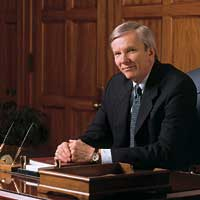
Edward Alton Parrish
In 1996, Edward Alton Parrish was inaugurated as 14th president. With Parrish came many new improvements to buildings, academic programs, and the social atmosphere of the campus. In the fall of 1997, Parrish was named a fellow of the Accreditation Board of Engineering and Technology (ABET). WPI’s Chemical, Civil, Electrical, Manufacturing, and Mechanical Engineering programs were all re-accredited by ABET. The renovation and rededication of Higgins Laboratories that took place in 1996, and the closing of West Street to through traffic, and the construction of Reunion Plaza were all finished under Parrish. The renovations of the residence halls were also begun in 1996 with Ellsworth/Fuller Apartments, followed closely by Sanford Riley, Daniels Hall, and finally Morgan Hall. Parrish focused greatly on the continuation of the WPI Plan and Global Perspective Program in his years at the Institute, and in 2001, the Campus Center was dedicated.

Dennis D. Berkey
When Dennis Berkey delivered his inaugural address as the 15th president of the university on May 20, 2005, he looked out over a Quadrangle where construction was under way for Bartlett Center, the new home for the offices of admissions and financial aid, which opened in 2006. The following month, the groundbreaking for Gateway Park, an 11-acre mixed-use life sciences–based development, heralded WPI’s partnership with the Worcester Business Development Corporation and celebrated the start of the project’s first building, the WPI Life Sciences and Bioengineering Center, located at 60-68 Prescott Street. This facility opened in early 2007. During the first year of Berkey’s administration, the creation of the Fuller Chemistry Complex brought about renovations to the freshman chemistry labs and changes in the first-year chemistry curriculum. The university’s Fire Protection Engineering program, begun in 1979 when WPI offered the nation’s first master’s degree program in this field, was elevated to the status of a full department. And the launch of the university’s Interactive Media and Game Development program, jointly administered by the Computer Science Department and Humanities and Arts Department, was the first major of its kind in the United States. Further improvements and expansions to the campus and its academic programs are planned in the coming years, such as the new Sports and Recreation Center (to open in fall 2012) abutting Harrington Auditorium.
See also Past Presidents of WPI.
Maintained by webmaster@wpi.edu